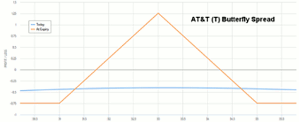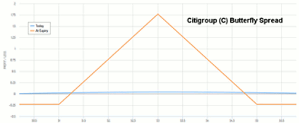In options trading, butterfly spreads sound more complicated than they really are, so James Brumley, of BigTrends.com, breaks them down using a couple of examples to clarify exactly how these four-option trades work.
Option Trading: Butterfly Spreads
A butterfly spread is a four-option trade (though only three strikes are used; two of the four are duplicates) entered on the premise that the underlying stock or index will move little to none before the options involved in the trade expire. In other words, it's considered a neutral position, and the trade itself can lose money if the chart in question moves too far in either direction. Butterfly spreads are so named as the shape of their profit and loss graph (loosely) resembles a butterfly.
The assembly of the trade involves buying two options and selling two options—all with the same expiration date—and can be constructed using calls or puts. Entering such a trade creates a debit or costs money upfront. The intent is to close out the trade at a later time at a net price greater than the initial debit. This will occur if the index or stock being traded doesn't move as the expiration date of the options approaches...or when it arrives.
Butterfly spreads are entered by buying one in-the-money option with a strike below the stock's/index's current price, selling (or shorting) two at-the-money options, and by buying one out-of-the-money option with a strike price above the current price of the stock or index in question.
A couple examples will clarify exactly how a butterfly spread works.
Let's assume AT&T (T) is likely to linger at its current price near $33 for a couple of months. To enter a butterfly spread—and take advantage of that stagnation—we would choose to buy a two-month call option with a strike above the current price—a strike of 35—and we would buy a two month option with a strike of 31, below the stock's current price. To offset some of that cost we would be two call options with a strike at 33 (we sell two at-the-money calls to balance the two different call options we're buying).
All told, the purchase of the 35 call costs us $0.16 (or $16 per contract), the purchase of the 33 contract costs us $2.28 (or $228 per contract), and we pocket $0.85 (or $85 per contract or $170 total) for the two 33 calls were shorting—or writing—for a total of net debt—or cost—of $74. [That net debit would rise for a larger trade, of course.]
NEXT PAGE: One More Time Using Puts Instead of Calls
|pagebreak|T Butterfly Spread Theoretical Profit/Loss Graph
The worst-case scenario is...AT&T shares are priced above $35 or below $31 at—or even before—expiration. In both cases, one or the other of the two long options will be in-the-money, but the other will be worthless. The short calls—the written calls with a strike price of 33—will almost certainly be exercised against us if T shares are priced above 33 before or at expiration, though we'll have the 31 call to help offset that risk. If T shares move below $31 at or before expiration, the pair of 33 calls will be worthless and pose no exercise risk, but both of the long calls will be worthless too. In those cases, the loss will be the $74 initial invested to enter the trade.
If, instead, AT&T shares are at $33 by the time expiration arrives, the shorted 33 calls expire worthless (meaning the $170 pocketed at their sale is fully retained), the 31 calls are worth $2.00 apiece (or $200 per contract), and the calls with the 35 strike are worthless. In that scenario we sell the 31 call for $200, more than offsetting the initial $74 debit needed to enter the trade, translating into a maximum profit of $126 for this particular butterfly spread.
It may be worth noting at this time that butterfly spreads are essentially the combination of a bull spread and bear spread, with overlapping strikes for the short/written option.
Let's work through another example, this time using puts instead of calls; the use of puts doesn't change the profit-and-loss profile.
Based on the assumption that Citigroup (C) shares are going to remain at or near their current price of $53.50 for the next month, we would want to buy one out-of-the-money put with a strike above $53.50, buy one in-the-money put with a strike below $53.50, and we want to sell—or write—two puts with a strike price as close to $53.50 as possible. In all cases, we're just buying options that expire in approximately one month.
To enter this trade, we would buy one-month 55 puts at a price of $2.63 (or $263 per contract), buy a one-month 51 put at $1.04 (or $104 per contract), and sell—or short—two puts with a 53 strike at $1.72 apiece (for a total of $344). In sum, this trade is entered at a total cost or debit of $23.
The worst case scenario is, we lose the initial $23 debit we paid to enter the trade...which would happen if C moves above $55 or below $51 before or by expiration. The best case scenario would be for Citigroup to close at $53 at expiration. At that point the 51 puts are worthless, both of the 53 puts would be worthless, and we could sell the 55 put at $2.00 (or $200 per contract). That credit minus the initial $23 debit would make our maximum possible gain $177.
C Butterfly Spread Theoretical Profit/Loss Graph
Again, bigger trades scale up the size of the potential gain or loss.
Butterfly spreads sound more complicated than they really are. But, it may take a couple of practice trades to fully learn the nuances and mechanics of them.
By James Brumley of BigTrends.com























